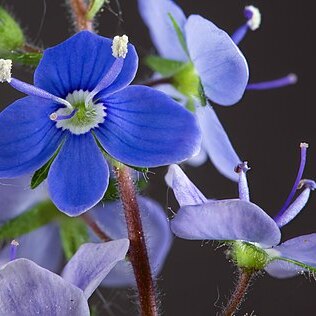Annual or perennial herbs, sometimes woody at base, sometimes shrublets. Lvs mostly opposite, sometimes alternate in infl., simple, entire to pinnatisect. Fls in terminal or axillary racemes, or solitary and axillary. Calyx deeply 4-(5)-lobed; lobes often unequal with upper 2 smaller. Corolla rotate to campanulate; tube short and much < limb; lobes 4, moderately dissimilar, the upper largest, mostly blue, less commonly pink or white, usually with blue veins. Stamens 2, exserted, spreading. Fr. a loculicidal or, less commonly, septicidal capsule, ± laterally compressed at right angles to septum, smooth or with raised nerves or ribs. Seeds few to fairly numerous, small; wing 0.
Cal deeply 4-parted in our spp. (5-parted in some no. 12 [Veronica officinalis L.]), the lobes equal or the upper shorter; cor-tube much shorter than the lobes (except in no. 1 [Veronica longifolia L.]), the limb rotate, obscurely 2-lipped, 4-lobed by fusion of the upper 2; stamens 2 (the upper pair), inserted at the orifice of the cor; pollen-sacs parallel; style exsert; stigma 1; fr short, often flattened, loculicidal and sometimes also septicidal, subtended by the sep and tipped by the persistent style; herbs with opposite (rarely whorled) foliage-lvs, the bracteal lvs mostly alternate or scattered; fls small, white to blue or purple. 300, N. Temp., especially Old World.
Stamens 2, perfect, exserted; inserted on corolla tube at sides of upper lobe; anther-thecae divergent or parallel, obtuse.
Leaves opposite or occasionally verticillate or scattered, entire or variously dentate or crenate.
Annual or perennial herbs, erect, prostrate or decumbent, glabrous or pubescent.
Flowers in terminal or axillary racemes or rarely solitary-axillary, bracteate.
Calyx 4-or 5-partite; where present, fifth posterior lobe usually smaller.
Corolla 4–5-lobed; tube short, rarely exceeding calyx.
Capsule compressed or turgid, bisulcate, loculicidal.
Style apically subcapitate.
Pedicels ebracteolate.
Seeds few to many.

